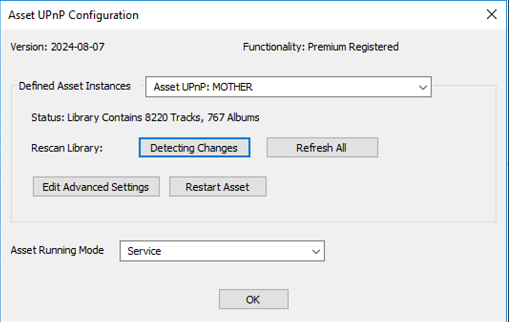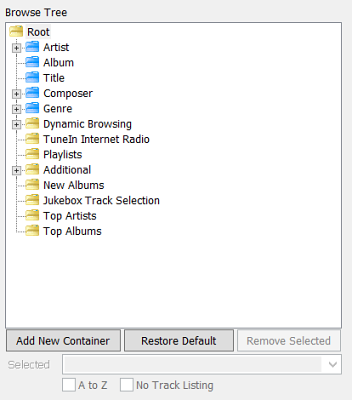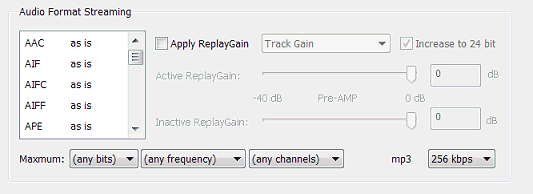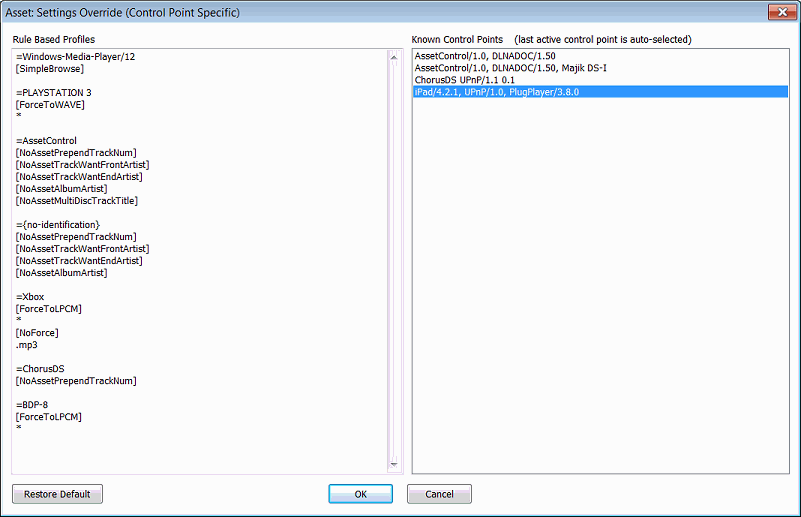The main Asset overview page, shows the status of Asset, its version, the number of tracks in the library:

Asset automatically monitors the watched music library folder(s), new tracks will be added automatically, it is also possible to force a rescan.
By default one instance of Asset is defined, each defined Asset can be thought as a separate server, each with their own settings or music library. It is possible for example to have a Christmas Asset indexing just festive tracks, this instance of Asset can be disabled once Christmas has passed.
Asset can be set to run as a service account (that is in the background when Windows Starts), however care must be take to ensure that Asset is allowed in your firewall (Asset uses port 26125), and that the service account has access permission to your music library.
Edit Advanced Settings

Audio Library
By default your Music folder is added, new tracks appearing anywhere in the Music folder
will be automatically indexed. A playlist folder can be added by clicking Add Folder and change the Contains item to Playlists. m3u and pls playlists are supported.

Exclude Audio Types can be used to inform Asset to not add certain types of audio files (for example your library consists of FLAC lossless files and mp3 files created from the FLAC files, in this instance mp3 should be excluded).
Audio stored on NAS Devices: folders can be added from another device (such as a NAS), before doing this open the share in Windows Explorer (Windows asks for a username and password to access, check the box to remember credentials), then Asset can access this share also,
if a network share does not appear, browse to it in Windows File
Explorer, right click on it and Map it as a Network drive, it will then
appear to Asset as a drive on the system.
Asset UPnP Identification can rename the Asset UPnP server name to something more suited to your personal requirements
The Artist & Album Handling has 3 modes (examples using The Beetles):
- Smart: this mode keeps the artist text as The Beetles, yet sorts the artist under 'B'
- Value, The: places the on the end, for example Beetles, The
- Leave as is: does not adjust the displayed value or sorted position
- Display in Sort and Non-Sort Locations: In the above example Beethoven would be listed under both 'L' and 'B', this option is default as an unexpected sort tag effectively hides the artist under the last name (think of Elvis Presley shown under 'P' with a sort tag of Presely, Elvis)
- Use Sort to Order Display: item is displayed in the sort tag location only
- Ignore Sort Values: does not use sort values from ID Tags
KT Tunstall & K T Tunstall,
Black Eyed Peas & The Black Eyed Peas
[All Tracks] and [Shuffle Tracks] for album listings: will place a selection at the top of the album selection page to enable the viewing of all tracks (from all the albums) and also a shuufled All Tracks listing.
[track #] - [title] for album track: is useful for control points which do not display a track number when showing an album, this option embeds the track number into a title. [artist] - [title] for Various Artist album tracks: for compilation albums and control points which do not show the individual artists, this option adds the artist name into the title
[title] - [artist] for Title Listing: someone requests the title Breathe, you might find there are 3 Breathes in your collection (David Grey, Kylie, Prodigy), this option for Title browsing only will place the artist after the title.
[album] - [artist] for album listings: for control points which do not display artists when browsing albums this option places the artist onto the album name (only for browsing), useful when looking for The Greatest Hits, as there could be 10 albums,
Multi-Disc Albums show as '[Disc] [Track] [Title]' many albums are released as multi-disc-albums, such as a Greatest Hits collection. Normally one album would be listed 'Greatest Hits' and tracks from disc 1, 2, 3 are all present under the same album (3 track 1's, not good). With this option checked there each album would follow in the correct order in one album folder.
Multi-Disc Albums sets how Asset handles albums which are split over multiple discs, by default the 2nd disc will added to the end of the first disc listing.
Fill Missing Album Artist Tags from Artist or Compilation Tags if set will always ensure the Album Artist tag is set.
Album Defined by Folder Asset needs to be able to seperate two 'Greatest hits albums' by different artists, normally the Album artist would be different, or a compilation tag set, however many auido collections are not as well tagged. This option defines an album by the location of the files, as typically all files for the same album are in the same folder.
Size Album Art allows the maximum art size to be set when browsing though a hand-held controller, the reduced size will give quicker responses.
UpStream Artwork enables artwork from the first discovered track to appear next to an Artist, or Genre
Menu Icons Background Color sets the main background color images shown in the browse tree for items such as 'Artists', it can be changed to match your control point.
Contributing Artists with Main Artists typically audio tracks might include featured artists (multiple artists), normally contributing artists are searched through Advanced Search >> Contributing Artist, with this option checked these 2nd artists are added to the main Artist browse.
A to Z Selection Grouping sets how artist and albums are grouped together in the quick A to Z selection which is presented after selecting Artist / Album,
Hide Main View Albums: when browsing by album it might to advantageous to not list CD singles, this option can filter those.
Dynamic Playlist Item Count determines the number of items to present in the dynamic playlists (such as newest tracks)
Detect & Catalog New Tracks by default Asset looks for new tracks or changes to tracks and catalogues these changes automatically
L24 (24 bit LPCM) Supported for devices which can support L24 this option enables 24 bit LPCM (there are very few if any players which currently support L24)
TuneIn Username allows favourite radio stations to be added an a user account (free to create) on tunein.com, type the user name into asset to access these favourites.
Manual Internet Radio Streams is used to specify fixed radio stations manually by URL and title. Note that the item 'User Radio Stations' needs to be added to the browse tree to browse these stations.
Settings Override (Control Point Specific) this allows editing of the rule sets for specific control points (see Override section below)
User Rename List (Display / Tag mapping) enables the shown tree names to be replaced, or ID tags to be changed (perhaps to blend all 'Pop / Rock' genres to 'Pop). Clicking [Edit Rename List] gives details of how to perform the renaming. Online Display / Tag mapping guide.
Library Exclusions enables tracks to be excluded based on ID Tag matches, for exmaple you could exclude all tracks with the genre Christmas, from your main library and include only Christmas genres in a 2nd Christmas instance of Asset. Clicking [Edit Exclusions] shows details on how to perform this.
Browse Tree
 |
Asset allows customization
of the browse tree, simplify it by removing items, or add new
browse-able items. Restore Default allows the restoration of the Browse Tree to default settings. |
Wave Streaming (including ReplayGain support)

Asset is able to decode the audio prior sending to a player, this would be useful if:
- The player does not support the audio format
directly, Asset is able to allow the player to play the audio tracks by
decoding them to PCM (either Wave or Linear), or mp3. Note that decoded audio files have no quality loss
(unless mp3 is used), they are as the player would play them (when it
decodes), if a format is left 'as is' it is sent untouched to the
player.
The option 'as is single' allows for say flac to only be offered as flac, normally 'as is' would offer FLAC, LPCM, WAV, FLAC this enables a player to pick FLAC if it supports, but also automatically chose LPCM or WAVE if it does not, as is single would only offer FLAC. - Apply ReplayGain ReplayGain is a method of measuring
loudness of audio tracks and altering the overall loudness, enabling tracks from
different albums to have the same volume levels (modern popular albums
are much louder than an album from the 1980's). ReplayGain requires
that the audio tracks have an embedded ReplayGain ID Tag
(dBpoweramp is able to add this tag to files, install dBpoweramp and the
ReplayGain utility codec from Codec Central on dbpoweramp.com, then run
the program 'Batch Converter', select the main audio folder (normally
Music) and select Convert >> choose the encoder the [ReplayGain]. This
method only scans the files and adds ReplayGain values, the audio is
left untouched).
Only tracks which are streamed (in a format other than 'as is') would have replaygain applied. If the player supports 24 bit audio then enable this option as it allows ReplayGain adjustments without any loss of bit depth when playing 16 bit tracks, also set the Active and Inactive pre-amp to -3 dB.
The
Maximum
option can be used to allow a player to play higher bit-depth files than
it can normally support (by automatically converting 24 bit to a maximum
of 16 bit), obviously though not at the higher resolution.
DSD handling: 'as is' sends untouched audio/x-dff or audio/x-dsf. 'as Wav' decodes the DSD to PCM. 'as DoP' embeds the DSD bitstream into a WAVE file, requires a DoP compatible DAC, only DSD64 files are supported
Settings Override
Settings Override allows to set a set of rules mainly to do with browsing, but also audio format specific, these rules are triggered by a known control point name. This is an advanced option and should not be edited lightly.

On the right hand side is a list of known control points, the highlighted is the last encountered. On the left hand side is a list of rules, they are in sections each starting with =, the list is searched looking for a match, partial names can be supplied, for example to set rules based for the iPad (when using PlugPlayer), you could set =iPad
The rules themselves can be:
[ForceAlbumArt=200]
to force 200 pixel album art
[StreamMax16Bit] sets the
maximum bits for streaming to 16
[StreamMax2Channels] sets
the maximum channels for streaming to 2
[StreamMax48KHz] sets the
maximum frequency for streaming to 48KHz
[SimpleBrowse]
is used to give a very simple browse tree (just tracks), this is used on
control points such as XBox which only need to catalog all tracks as
quickly as possible.
[NoAssetPrependTrackNum] see
[track #] - [title] for album tracks
[NoAssetTrackWantFrontArtist] see
[artist] - [title] for Various Artist album tracks
[NoAssetTrackWantEndArtist] see
[title] - [artist] for Title Listing
[NoAssetAlbumArtist] see
[album] - [artist] for album listings
[NoAssetMultiDiscTrackTitle] see
Multi-Disc Albums show as '[Disc] [Track]
[Title]'
[NoAllTracksItems] stops the listing of [All Tracks]
in album listings
[SimpleArtist] to not supply composer, conductor or
album artist (only artist) for track details to player
[ForceToWAVE] [ForceToMP3] [ForceToLPCM] [ForceToSINGLE] these three options force the streaming (transcoding), after setting this option follow with a list of extensions ';' deliminated, finalizing with a blank line, for example:
[ForceToLPCM]
.mp3;.flac
A * can be used to signify all extensions, single
extensions can be excluded with [NoForce] (see the =Xbox example in
the picture, all formats except mp3 are forced to LPCM streaming).
See
'as is single' above for details on [ForceToSINGLE]
={no-identification} is a special identifier, for control points that do not match any other present rule set.